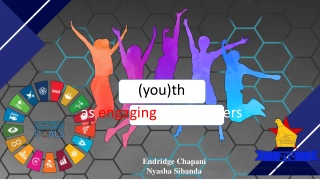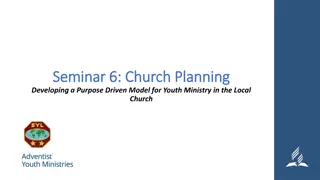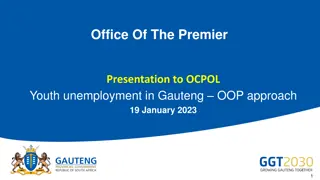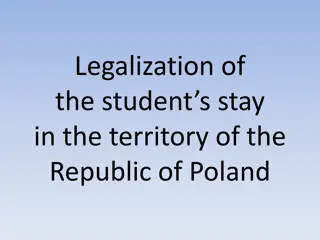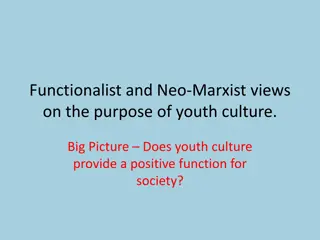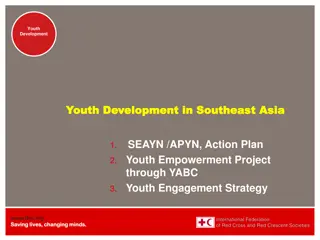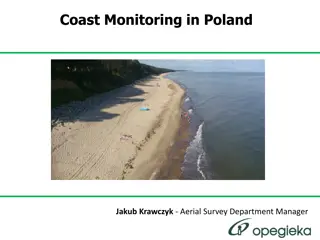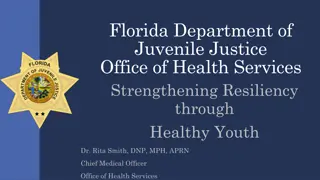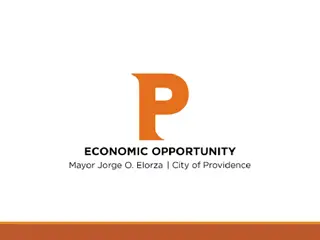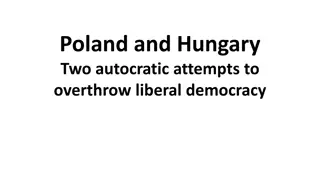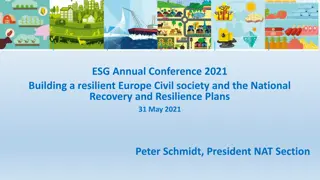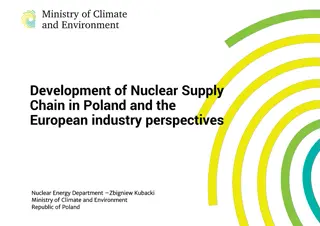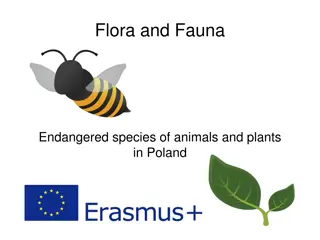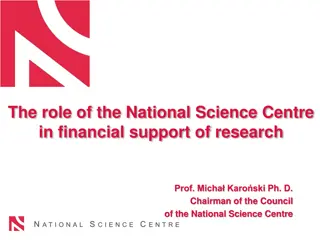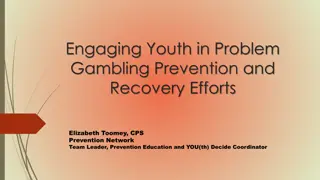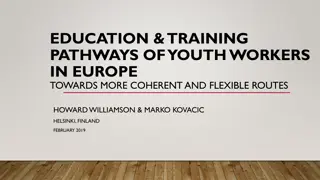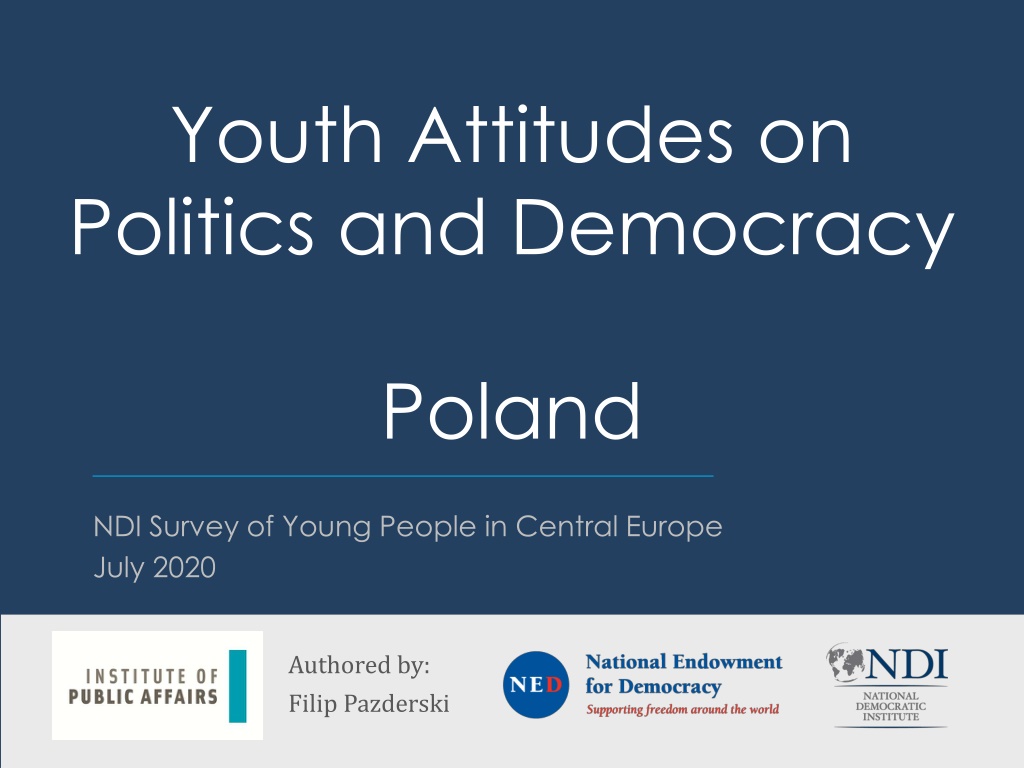
Youth Attitudes on Politics and Democracy in Poland Survey 2020
Explore the findings of the NDI survey on Youth Attitudes on Politics and Democracy in Poland, conducted among young people aged 16-29. The research covers various aspects, including political participation, democratic values, COVID-19 impact, identity, priorities, and information sources. Gain insights into the satisfaction levels with the current political situation in Poland and understand the perspectives of the youth.
Download Presentation

Please find below an Image/Link to download the presentation.
The content on the website is provided AS IS for your information and personal use only. It may not be sold, licensed, or shared on other websites without obtaining consent from the author. Download presentation by click this link. If you encounter any issues during the download, it is possible that the publisher has removed the file from their server.
E N D
Presentation Transcript
Youth Attitudes on Politics and Democracy Poland NDI Survey of Young People in Central Europe July 2020 Authored by: Filip Pazderski
RESEARCH METHODOLOGY FIELDWORK PERIOD SAMPLE DESIGN The sample is statistically representative of the Polish population aged 16-29 in terms of gender, education level and place of residence. 2-7 July, 2020 SAMPLE SIZE TYPE OF SURVEY 750 respondents Age: 16-29 Margin of error: 3,58% Computer-Assisted Web Interview (CAWI)
SOCIO-DEMOGRAPHIC CHARACTERISTICS OF RESPONDENTS REGION GENDER SETTLEMENT SIZE MAZOWIECKIE 13% L SKIE 11% 1% 46% VILLAGES AND COUNTRYSIDE MA OPOLSKIE 9% WIELKOPOLSKIE 9% CITY WITH LESS THAN 20,000 RESIDENTS DOLNO L SKIE 7% 13% 49% 50% POMORSKIE 6% CITY BETWEEN 20,000-100,000 RESIDENTS DZKIE 6% 18% PODKARPACKIE 6% CITY BETWEEN 100,000-500,000 RESIDENTS LUBELSKIE 6% 14% KUJAWSKO-POMORSKIE 6% ZACHODNIOPOMORSKIE 4% CITY WITH OVER 500,000 RESIDENTS 9% Men Female Prefer not to say WARMI SKO-MAZURSKIE 4% WI TOKRZYSKIE 3% PODLASKIE 3% LUBUSKIE 3% OPOLSKIE 2% EDUCATION primary vocational or secondary without school leaving matura full secondary with matura and I don't continue learning full secondary, with matura and I continue learning university degree (incl. BA level, + PhD) AGE 16-19 y.o. 20-24 y.o. 25-29 y.o. 14% 21% 19% 22% 23% 25% 34% 41%
CONTENT 1. POLITICAL PARTICIPATION 2. DEMOCRATIC VALUES 3. COVID-19 PANDEMIC ANALYSIS 4. IDENTITY 5. POLITICAL PRIORITIES AND SOURCES OF INFORMATION 6. CONCLUSIONS
POLITICAL PARTICIPATION Are you satisfied or dissatisfied with the current political situation in Poland? Dissatisfaction with political life in the country has significantly increased since 2018 100% 8% 90% 80% 30% 70% Do not know 60% NOTE Not satisfied at all 50% Rather dissatisfied Two thirds of respondents expres their dissatisfaction with Polish political situation Slightly above a quarterof population tends to be satisfied 33% Rather satisfied 40% Very Satisfied 30% 20% 22% 10% 7% 0%
POLITICAL PARTICIPATION To what extent are you satisfied or dissatisfied with the government? Satisfaction with Polish government has decreased since 2018 by 10 p.p. 100% 7% 90% 80% 34% NOTE 70% Don't know Less then one third of respondents expres their satisfaction with the government in Poland Dissatisfaction has increased to 64% in 2020 The number of dissatisfied people is much smaller among the inhabitants of rural areas (29% compared to 41-42% people of cities with 20-100,000 inhabitants, 33% of residents in the municipalities with 100-500,000 inhabitants and 39% of the towns with over 500,000 inhabitants) 60% Not satisfied at all 50% Rather dissatisfied Rather satisfied 30% 40% Very satisfied 30% 20% 24% 10% 5% 0%
POLITICAL PARTICIPATION Describe your involvement in the following political activities: The most frequent political participation is voting, followed by less demanding online activities Yes I have been involved No, I have not been involved, but I plan to get involved No, I have not been involved, and I do not plan to get involved I do not know 6% 19% 67% 8% MEMBERSHIP IN A POLITICAL PARTY POLITICAL ACTIVITY 11% 21% 56% 11% TAKING PART IN A DEMONSTRATION CONTACTING A POLITICIAN OR LOCAL POLITICAL REPRESENTATIVE WITH PARTICULAR PUBLIC ISSUE OR OFFICIAL REQUEST NOTE 10% 22% 57% 10% SIGNING A PETITION ON THE STREET OR AT ANOTHER PLACE NOT INCLUDING THE INTERNET Electoral participation is the most obvious political participation among the youth 39% has already signed an online petition and a further 20% plan to do so More than one-quarterhas signed a petition or motion in the street and the same numberis up for that in the future Even larger group (40%) has already took part in crowd-funding But other activities of political character are less popular (incl. demonstration) Volunteering is more popular outside Covid-19 related matters 27% 27% 37% 10% 39% 20% 32% 10% PARTICIPATING IN AN ONLINE PETITION OR PROTEST INTERNET PUBLICLY SHARING OR EXPRESSING YOUR IDEAS ON POLITICS OR IMPORTANT PUBLIC ISSUES THROUGH BLOGS, COMMENTS TO THE MEDIA, SOCIAL NETWORKS, PUBLIC 28% 16% 46% 10% 40% 25% 26% 9% SUPPORTING AN ONLINE CROWD-FUNDING CAMPAIGN 57% 19% 16% 9% ...IN NATIONAL ELECTIONS VOTING 54% 21% 16% 9% ...IN LOCAL ELECTIONS VOLUNTEERIN 27% 21% 41% 11% IN GENERAL (EXCLUDING COVID-19 RELATED INITIATIVES) G 9% 22% 57% 12% ...IN COVID-19-RELATED INITIATIVES
DEMOCRATIC VALUES Commitment for democratic political system remains distinct, but it has fallen since 2018 by 18% How would you describe each of the following governing systems: Very good Fairly good Fairly bad Very bad Do not know NOTE HAVING A DEMOCRATIC POLITICAL SYSTEM IN WHICH DECISIONS ARE MADE THROUGH LEGISLATIVE DELIBERATION AND PUBLIC CONSULTATION. The large majority of Poles (71%) see democratic political system as good or very good (BUT it was 89% in 2018) However, 26% think that a strong leader would be good for Poland (20% in 2018) Therefore, support to democracy has decreased, while recognition of a system based on a strong leader has increased duringlast 2 years Much larger group of Poles don t have an opinion, whether a system based on strong leader is good or bad for their country (15% compared to 1% in 2018!) 36% 35% 13% 4% 13% HAVING A STRONG LEADER WHO DOES NOT NEED TO CONSULT WITH PARLIAMENT AND CIVIL SOCIETY. 8% 18% 24% 34% 15% 0% 20% 40% 60% 80% 100%
DEMOCRATIC VALUES Two-thirds of respondents see democracy as the best possible political system To what extent do you agree with the following statements: I fully agree I somewhat agree I somewhat disagree I fully disagree I do not know DEMOCRACY IS THE BEST POSSIBLE SYSTEM OF GOVERNMENT 24% 42% 15% 8% 12% NOTE Young respondents show high commitment for democracy For overwhelming majority (72%) it does matter whether the government is democratic or not However, there is a large group of respondents that are open to restricting human rights and civil liberties on certain conditions from two-fifths that would agree for such restriction in exchange for higher standards of living and safety from threats, up to over 50% that would agree for the same in exchange for health security during the pandemic According to 60% democracy is good only until it delivers economic growth IT DOES NOT MATTER IF THE GOVERNMENT IS DEMOCRATIC OR UNDEMOCRATIC 4% 11% 27% 45% 12% SOMETIMES, HUMAN RIGHTS AND CIVIL LIBERTIES SHOULD BE RESTRICTED IN ORDER TO BETTER PROTECT PEOPLE FROM TERRORISM AND OTHER THREATS 10% 32% 28% 16% 14% I WOULD BE READY TO SACRIFICE SOME CIVIL LIBERTIES TO SECURE HIGHER STANDARDS OF LIVING 10% 27% 25% 18% 19% I WOULD BE READY TO SACRIFICE SOME FREEDOMS FOR HEALTH AND SAFETY DURING THE PANDEMIC 15% 37% 20% 12% 16% DEMOCRACY IS THE BEST POSSIBLE SYSTEM OF GOVERNMENT ONLY WHEN IT CAN DELIVER ECONOMIC SECURITY FOR PEOPLE 21% 38% 15% 8% 18%
COVID-19 RESPONSE ASSESSMENT To what extent are you satisfied with the work of the following institutions during the COVID-19 crisis? Local authorities, CSOs and the EU are the most positively evaluated in their fight against Covid-19 outbreak Very satisfied Rather satisfied Rather dissatisfied Not satisfied at all Do not know THE GOVERNMENT 7% 25% 30% 29% 9% NOTE PARLIAMENT 3% 22% 35% 23% 17% Around half of population positively evaluate activities taken to counteract Covid-19 pandemic by local authorities and CSOs, only a bit less is satisfied with the EU On the other hand, majority groups negatively assess work of all central authorities with the largest shares dissatisfied with activities of the president(60%) and the government (59%) Satisfaction with work of the parliament (exluding its upper chamber), government and presidentis higher in rural areas SENATE 4% 24% 34% 20% 18% THE PRESIDENT 12% 21% 22% 38% 8% MAYOR OF THE TOWN/MUNICIPALITY 11% 43% 19% 12% 16% CIVIL SOCIETY ORGANISATIONS 9% 41% 17% 10% 24% EUROPEAN UNION 9% 37% 21% 16% 17%
COVID-19 RESPONSE ASSESSMENT Name one good measure introduced by the national or local government in response to the pandemic. Most frequently mentioned measures are related to social distancing, face covering, hand disinfection, lockdown in economy and quarantine (social and personal) 42.4% SOCIAL DISTANCE, FACE COVERING AND ADDITIONAL HYGIENE MEASURES, 11.1% NO OPINION 8.3% NO GOOD SOLUTIONS 8.0% ANTI-CRISIS SHIELD AND SUPPORT FOR BUSINESS 7.1% CLOSURE OF EDUCATIONAL INSTITUTIONS AND REMOTE EDUCATION NOTE 6.0% BORDERS' CLOSURE / PLANE TRAFFIC SUSPENSION 2/5 of answers is related to the most basic measures taken 8% of opinions mention supportto economy, 7% closing educational institutions and 6% closing borders Ca. 2,5% mention various supportto employees (incl. unemployed) & parents Slightly above 3% point out various solutions adoptedby local authorities (mostly protective materials distribution) 4% don t believe that Covid-19 poses a serious threator even swears the conspiracy Other include, i.e. elections, public administration digitalisation of the services (3 mentions), ban on refugees, quarantine application or asking for greater financial support (2 mentions) 4.1% SWIFT OF RESPONSE 4.0% SUPPRESSING RESTRICTIONS AND UNDERESTIMATING DANGER 3.3% LOCAL SOLUTIONS INTRODUCED BY LOCAL AUTHORITIES 2.8% RESTRICTIONS AND SPECIAL ARRANGEMENTS IN TRADE FACILITIES 2.5% SUPPORT FOR EMPLOYEES 2.4% SUPPORT FOR PARENTS AND GUARDIANS 1.9% INCREASED RESTRICTIONS ARE NEEDED 1.3% OTHER 1.1% CRITICISM OF GOVERNMENT - FOR CONCEALING THE TRUTH, FRAUD 0.9% REMOTE WORK 0.7% WAYS OF COMMUNICATION ABOUT THE PANDEMIC 0.5% SOLUTIONS IN MEDICINE 0.4% SPECIFIC SOCIAL ACTIONS 0% 10% 20% 30% 40% 50% 60%
COVID-19 RESPONSE ASSESSMENT Majority supports the way Polish government handled the crisis, but larger group accuse it for fraud and is concerned about own future economic situation To what extent do you agree or disagree with the following statements: I fully agree I somewhat agree I somewhat disagree I fully disagree I do not know POLISH GOVERNMENT RESPONDED EFFECTIVELY TO THE PANDEMIC 16% 41% 25% 14% 5% NOTE THE GOVERNMENT HAS FAVORED THE OLDER GENERATION AT THE EXPENSE OF YOUTH IN ITS RESPONSE TO THE COVID-19 EPIDEMIC 14% 30% 31% 11% 14% Majority of Poles (57%) evaluates a way in which goverment respondedto the pandemic as effective But more people (47%) think the way Polish governmenthandled the crisis and the measures limiting citizens individual rights were not reasonable than hold the opposite opinion (43%) Half of Poles is also concerned that measures proposed by the government are a burdento the economy and majority (56%) think their purpose was rather to misuse public funds The largest majority (64%) is concerned about own professional and economic situation in the future THE WAY POLISH GOVERNMENT HANDLED THE PANDEMIC CRISIS AND THE MEASURES LIMITING INDIVIDUAL RIGHTS OF THE CITIZENS WERE REASONABLE AND UNDERSTANDABLE TO THE SITUATION 9% 34% 31% 16% 10% THE MEASURES POLISH GOVERNMENT PROPOSED TO STOP THE FURTHER DEVELOPMENT OF THE EPIDEMIC WERE TOO EXTENSIVE, UNDULY THREATENING THE FUNCTIONING OF THE ECONOMY 17% 32% 28% 11% 11% THE GOVERNMENT USED THE PANDEMIC CRISIS AND EXTRAORDINARY MEASURES TO MISAPPROPRIATE PUBLIC MONEY 26% 31% 16% 10% 17% DUE TO THE PANDEMIC CRISIS I AM CONCERNED ABOUT MY FUTURE PROFESSIONAL AND ECONOMIC SITUATION MORE THAN BEFORE 30% 34% 19% 8% 10%
COVID-19 RESPONSE ASSESSMENT The largest group of the population recognizes that the pandemic has worsened ruling party relations with opposition In what way has COVID-19 impacted relations between the government parties and the opposition? RESPONSES ACROSS THE POPULATION AND BY THE LEVEL OF EDUCATION 100% 13% 21% 22% 23% 25% 31% 80% 24% 9% 21% 19% 19% 15% 60% NOTE 16% 31% 20% 21% 14% 22% Two-fifths (39%) of respondents say Covid-19 has deterioratedrelations between the government and oposition and only 9% has an opposite opinion Recognition of significant deterioration increases with the level of education achieved - 1/4 of people with higher education are of this opinion But people with primary education are less firm in their opinions - their largest group (31%) perceives slight deterioration in these relations 40% 39% 26% 30% 27% 29% 20% 30% 8% 6% 3% 6% 8% 5% 6% 3% ALL 2% 1% 0% 2% 2% FULL SECONDARY, WITH MATURA AND I CONTINUE LEARNING PRIMARY VOCATIONAL OR SECONDARY WITHOUT SCHOOL LEAVING MATURA FULL SECONDARY WITH MATURA AND I DON'T CONTINUE LEARNING UNIVERSITY DEGREE (INCL. BA LEVEL, + PHD) Improved significantly Improved slightly Did not change Deteriorated slightly Deteriorated significantly I don t know
IDENTITY To what extent do you identify with the following entities? The strongest declared identification is with Poland and Europe Very much Somewhat Not really Not at all Do not know MY NATION 29% 41% 15% 6% 9% NOTE 70% identifies themselves with Poland and only one-fifthdo not Identification with Europe is by 10 p.p. weaker than with Poland The order of preferences in identification is the same as in 2018, but the level of each positive declaration has decreased (by 20 p.p. in case of four most popular features) More men are strongly identified with nation than women (34 to 23%), while more residents of the largest cities (24%) strongly identify with Europe then people from all other areas (13- 17%) EUROPE 16% 44% 21% 8% 11% MY RELIGION 24% 31% 18% 15% 12% MY LOCAL COMMUNITY 16% 35% 26% 11% 13% POLITICAL PARTY I'VE VOTED / WOULD VOTE FOR 15% 32% 22% 15% 15%
IDENTITY The Covid-19 crisis has increased trust and cooperation between European Union and member states. In opinion of the majority of people Covid-19 outbreak has not increased cooperation within the EU RESPONSES BY THE LEVEL OF EDUCATION Fully agree Somewhat agree Somewhat disagree Fully disagree Do not know 13% 15% 18% 18% 22% 23% 20% 13% 17% 22% 9% 16% NOTE 31% 22% 32% 37% 28% Half of the respondents don t agree that Covid-19 pandemic has increased trust and cooperation in the EU, while 3 in 10 people hold an opposite opinion Disagreement with this statement increases among people with higher education and is the smallest in a group with vocational or secondary education 41% 28% 31% 27% 29% 25% 21% 11% 7% 7% 5% 5% 5% ALL UNIVERSITY DEGREE (INCL. BA LEVEL, + PHD) FULL FULL SECONDARY WITH MATURA AND I DON'T CONTINUE LEARNING VOCATIONAL OR SECONDARY WITHOUT SCHOOL LEAVING MATURA PRIMARY SECONDARY, WITH MATURA AND I CONTINUE LEARNING
5. POLITICAL PRIORITIES AND SOURCES OF INFORMATION
POLITICAL PRIORITIES AND SOURCES OF INFORMATION The majority declares having some interest in politics, but this group has shrunk since 2018 How interested are you in politics and public affairs? 100% 7% 90% 80% 22% 70% Do not know 60% Not at all interested NOTE Not very interested 50% Somewhat interested 50% One-thirdof the respondents have no interest in politics and public affairs (or don t have an opinion on that). Declared interest grows alonsgsite achieved level of education. 40% Very interested 30% 20% 10% 18% 0%
POLITICAL PRIORITIES AND SOURCES OF INFORMATION Has the COVID-19 crisis increased your level of interest in politics in public affairs? More than half got interested morein politics amidst COVID- 19 pandemic RESPONSES ACROSS THE POPULATION AND BY GENDER Definitely Somewhat Not really Not at all Do not know 100% 4% 4% 5% 9% 11% 90% 11% 80% 28% 70% 33% 38% 60% NOTE 50% 52% of the respondents admit their interest in politics has grown due to the COVID-19 crisis It s significantly more women than men (60% to 46%), whose interest in politics has increased 40% 40% 34% 29% 30% 20% 10% 20% 18% 17% 0% ALL MEN WOMEN
POLITICAL PRIORITIES AND SOURCES OF INFORMATION How satisfied are you with the government s communication during the COVID-19 crisis? Only minority is satisfied with a way how government communicated about pandemic RESPONSES ACROSS THE POPULATION AND BY THE PLACE OF RESIDENCE Very satisfied Rather satisfied Rather dissatisfied Not satisfied at all Do not know 5% 8% 9% 10% 10% 10% 25% 20% 17% 20% 20% 23% NOTE 30% 32% 30% 33% 29% 44% 39% of the respondents evaluate positively governmetal information policy related to COVID-19 crisis, whereas 52% holds negative opinion Numbers of positive opinions on the government s communication are higher in the rural areas and decreases as the size of the respondents city of residence increases 34% 30% 31% 30% 29% 23% 9% 8% 8% 8% 8% 5% ALL RESPONDENTS VILLAGES AND COUNTRYSIDE CITY WITH LESS THAN 20,000 RESIDENTS CITY BETWEEN 20,000-100,000 RESIDENTS CITY BETWEEN 100,000-500,000 RESIDENTS CITY WITH OVER 500,000 RESIDENTS
POLITICAL PRIORITIES AND SOURCES OF INFORMATION How frequently do you use the following sources of information: Facebook and online news outlets are the most popular sources of information Very regularly Rather regularly Rarely Not at all Do not know FACEBOOK 50% 28% 12% 8% 2% PUBLICLY AVAILABLE WEB PORTALS (ONLINE ONLY) 22% 33% 29% 12% 3% NOTE PRIVATE RADIO 22% 30% 31% 14% 3% 78% of respondents use FB regularly as a source of information on society and politics Online, publicly available news outlets come at second place (55% use it regularly) and is followed by private radio (52%) and privateTV (51%). Video blogs on YouTube consist a regular source of informationfor 48% (it was 30% in 2018) Also regular use of Twitter and private blogs increased from 2018 both by 13%, of private TV by 11% , public TV by 6% and of Facebook by 5% The outreach of the so-called alternative media remains marginal, but also has increased by ca. 15% PRIVATE TV 22% 29% 30% 16% 2% VIDEO BLOGS ON YOUTUBE 24% 24% 25% 22% 5% PUBLIC TV 14% 18% 31% 35% 2% PRIVATE BLOGS 10% 15% 26% 44% 5% TWITTER 13% 10% 19% 52% 6% TRADITIONAL PRINT MEDIA OUTLETS OR THEIR WEBSITES 7% 11% 33% 44% 4% PUBLIC RADIO 6% 12% 34% 44% 3% "ALTERNATIVE" MEDIA (I.E. NP. KRESY.PL, XPORTAL.PL, PRAWY.PL ) 6% 10% 25% 53% 6%
POLITICAL PRIORITIES AND SOURCES OF INFORMATION To what extent do you trust the following media sources regarding news on COVID-19? When reporting on the Covid-19 pandemic is concerned it s more traditional media - especially private radio and TV that gain in trust Full trust Rather trust Rather do not trust Do not trust at all Do not know PRIVATE RADIO 6% 48% 20% 12% 13% PRIVATE TV 8% 42% 24% 18% 8% PUBLICLY AVAILABLE WEB PORTALS (ONLINE ONLY) 6% 39% 26% 15% 13% FACEBOOK 7% 35% 31% 14% 13% NOTE VIDEO BLOGS ON YOUTUBE 9% 33% 21% 14% 23% Only private traditional media gain trust of at least 50% of respondents in informing on the outbreak Online, publicly available news outlets fall to 3rd place and Facebook is 4th with 42% of people who trust this platform, while 45% have an opposite opinion The greatest lack of trust is in the information providedby public media as 65% of Poles don t believe it (it's more distrustfuleven then alternative media, which are less known) PRIVATE BLOGS 5% 25% 23% 18% 29% PUBLIC TV 6% 22% 20% 45% 8% TRADITIONAL PRINT MEDIA OUTLETS OR THEIR WEBSITES 4% 23% 26% 23% 24% PUBLIC RADIO 4% 22% 24% 32% 18% TWITTER 5% 19% 23% 20% 32% "ALTERNATIVE" MEDIA (I.E. NP. KRESY.PL, XPORTAL.PL, PRAWY.PL ) 3% 18% 22% 24% 32%
POLITICAL PRIORITIES AND SOURCES OF INFORMATION Rising prices and costs of living, healthcare, environment and unemployment are perceived as the most serious problems How serious is each of the following issues in Poland: A very serious problem Somewhat of a serious problem Not a significant problem Not at all a serious problem Do not know RISING PRICES, COSTS OF LIVING 59% 28% 5% 3% 5% HEALTHCARE 55% 32% 6% 1% 6% NOTE ENVIRONMENT 44% 34% 11% 4% 6% UNEMPLOYMENT 43% 35% 13% 3% 7% Perceived seriousness of particular problems has changed significantly since 2018; these opinions seem to be influenced by current events and the content of the public debate Considering the assessment of the problems as "very" and somewhat of a serious" rising prices and costs of living are rated highest - It is indicated by almost 9 out of 10 people (78% in 2018), health care is right after (81% in 2018, so the change is small), and the importance of the environment, unemployment and climate change has increased significantly and is in 3rd place (2 years ago it was 52%, 49% and 43%) The perception of the importance of the democratic crisis has also increased (59% in 2018). CLIMATE CHANGE 44% 30% 14% 5% 6% ECONOMIC RECOVERY 35% 39% 12% 5% 10% PENSIONS 36% 37% 15% 4% 8% EDUCATION 37% 35% 16% 5% 7% COVID-19 PANDEMIC 35% 37% 15% 7% 6% DEMOCRATIC DECLINE AND RISING AUTHORITARIANISM 38% 33% 12% 6% 11% CORRUPTION 40% 31% 16% 3% 11% CRIME 26% 40% 23% 4% 7% RUSSIAN MILITARY BUILDUP AND RUSSIAN 28% 36% 17% 7% 11% IMMIGRATION 26% 33% 23% 9% 9% TERRORISM 28% 27% 27% 10% 8% THREATS TO TRADITIONAL CULTURE 19% 31% 28% 12% 11% EVOLVING GENDER ROLES 23% 20% 22% 25% 10%
POLITICAL PRIORITIES AND SOURCES OF INFORMATION Poles seem to show relative resistance to disinformation on the origins of Covid-19 virus To what extent do you agree or disagree with the following statements: Fully agree Rather agree Rather disagree Fully disagree Do not konw COVID-19 ORIGINATED IN THE WUHAN FOOD MARKET AND SPREAD OUT AROUND THE WORLD BECAUSE THE CHINESE GOVERNMENT FAILED TO ADMIT THE VIRUS WAS BEING TRANSMITTED AMONG PEOPLE ON TIME. NOTE 23% 35% 15% 8% 19% Majority (58%) holds rather realistic opinion on the reasons of the Covid- 19 outbreak However, large group (46%) repeats one of the conspiracy theories directed against the Chinese government One-fifthof Poles shares an opinion disseminated rather by Chinese or Russian propaganda (that it s the U.S. to be blamed for the virus) Significant number of respondents (one-fifth) do not have an opinion on the sources of Covid-19 outbreak COVID-19 VIRUS WAS RELEASED BY CHINESE SCIENTISTS. 19% 27% 22% 13% 19% COVID-19 VIRUS WAS RELEASED BY US SCIENTISTS. 7% 14% 27% 31% 21% 0% 20% 40% 60% 80% 100%
CONCLUSIONS Dissatisfaction with political life in Poland and the government has increased since 2018; interest in politics remains large but also has deteriorated. Majority support the way Polish government handled the Covid-19 crisis, but more accuse it for fraud and is concerned about own future economic situation and work. Commitment for democratic political system remains strong, but it has fallen since 2018 by 18%; it also remains fragile - the most important reason for which people would trade civic freedoms off (during pandemic crisis) is public health. The most frequent form of political participation is voting, followed by less demanding online activities (especially signing online petitions and crowd-funding). Membership in political parties has slightly increased, but trend is the opposite in all other means of political participation, what may show growing youth disillusionment with the sense of active citizenship. European identity is strong the 2nd strongest after the national one. Facebook and online news outlets are the most popular sources of information and the role of videoblogs on YT raised; but, it s more traditional media (especially private radio and TV) that are trusted in reporting on the Covid-19 pandemic matters. The most serious problem for youth is rising prices and costs of living, healthcare, environment and unemployment actions responding to them can be used to engage with this group.

